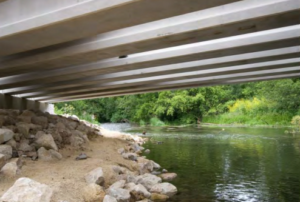By Roxy Franta
February 1, 2016
A passage bench, or “critter crossing,” is a gravel walking path incorporated into the riprap along a bridge abutment to allow wildlife to pass under bridges uninterrupted. Many species of wildlife travel along the natural shoreline of streams, but modern infrastructure often breaks the continuity of the shoreline. Traditional riprap is not passable by many animals, forcing them to leave the shoreline and cross at busy bridge approaches. Wildlife on roadways presents safety hazards to both the animal and drivers, but including a passage bench into bridge design is an easy solution to this common problem in Minnesota.

(photo credit: Minnesota Department of Natural Resources)
Why include a passage bench?
The idea of a passage bench was developed by the Minnesota Department of Natural Resources (DNR), the U.S. Fish and Wildlife Service (USFWS), and the Minnesota Department of Transportation (MnDOT) in 2005. Continued observations prove this feature to be successful, providing benefits such as:
- Movement of animals under the bridge, increasing road safety of bridge approaches
- Safe footing for bridge inspectors and fishers
- Access for maintenance
- Flexibility in design for cross-section of normal channel and flood profile
- Riprap design change from aggregate base to geotextile base
- No extra cost or time to install
- Wildlife conservation by minimizing deaths from collision
Designing a bench
In 2011, the passage bench became part of the MnDOT Standard Plan Set for use on all bridges. Specifications for passage bench design can also be found in the “Best Practices for meeting DNR General Permit 2004-0001, March 2006” guidelines.
The passage bench is a level trail from one side of the bridge to the other. It should be constructed of any size aggregate that is “walkable,” to allow wildlife proper footing as they pass under the bridge. The bench should be placed at or slightly above the adjacent bank elevation to create a continuous path that mimics the natural contours of the streambank and should be tied into the groundline outside the bridge area. A typical game trail width of three feet has proven to be successful for animal movement.
Common mistakes
The passage bench is a relatively simple addition to bridge construction, but there are some common mistakes to avoid during installation.
- Having the riprap block the path. It’s important to incorporate the passage bench into both the grading and bridge plans to ensure it is completed and continuous across the entire area. Drainage outfalls and associated riprap along the abutment should be placed below the bench.
- Too high or too low. The height of the passage bench often doesn’t match the natural streambank. A good indicator for the bench elevation is to place it at or just above the vegetation line.
- Lack of guidance for wildlife. Though not a requirement in Minnesota, the right-of-way (ROW) fence should be used to guide wildlife to the passage bench. ROW fencing is often extended parallel to the roadway until it reaches the stream at the bridge. Instead, the fence should be turned up at the abutment and installed tight against the bridge corner. If it is a divided highway, a median fence should be installed as well.
- Too skinny. MnDOT specifications suggest a minimum bench width of three feet. Benches that are too narrow are subject to longitudinal scouring during flood events and are not used as often by wildlife.
- Construction phasing. Contractors often wait to install the passage bench until all other work is complete, but this makes it impossible to mechanically install it once the bridge beams are set in place. Installation should occur with riprap installation and should be a planned part of construction phasing.
Success
MnDOT funded a study of the passage bench and collected data on wildlife movement and utilization in 2009. They concluded that a wide variety of species use the passage including black bear, red fox, gray fox, bobcat, whitetail deer, and even humans.
Roadway networks have caused fragmentation in the natural environment, but as a construction planner, design engineer, or contractor, you can help minimize this conflict between wildlife and highway operation with the inclusion of a passage bench.
Resources:

